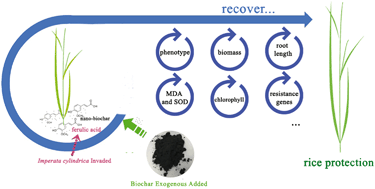当前位置:
X-MOL 学术
›
Environ. Sci.: Nano
›
论文详情
Our official English website, www.x-mol.net, welcomes your
feedback! (Note: you will need to create a separate account there.)
Role of nano-biochar in attenuating the allelopathic effect from Imperata cylindrica on rice seedlings
Environmental Science: Nano ( IF 5.8 ) Pub Date : 2019/12/02 , DOI: 10.1039/c9en00828d Yu Shen 1, 2, 3, 4, 5 , Haiyan Tang 1, 2, 3, 4 , Wenhao Wu 5, 6, 7, 8 , Heping Shang 5, 6, 7, 8 , Di Zhang 4, 9, 10, 11 , Xinhua Zhan 1, 2, 3, 4 , Baoshan Xing 5, 6, 7, 8
Environmental Science: Nano ( IF 5.8 ) Pub Date : 2019/12/02 , DOI: 10.1039/c9en00828d Yu Shen 1, 2, 3, 4, 5 , Haiyan Tang 1, 2, 3, 4 , Wenhao Wu 5, 6, 7, 8 , Heping Shang 5, 6, 7, 8 , Di Zhang 4, 9, 10, 11 , Xinhua Zhan 1, 2, 3, 4 , Baoshan Xing 5, 6, 7, 8
Affiliation

|
It is reported that Imperata cylindrica, a successful invasive plant in North America, has covered many parts of the United States, especially the southeastern region which is the main rice growing region. The invasion of I. cylindrica could threaten rice production. In this study, we hypothesize that biochar nanoparticles (nano-BC) can reduce the stress from the root exudates of I. cylindrica. Ferulic acid (FA) is a major chemical of I. cylindrica root exudates, and we selected its analog, salicylic acid, as an experimental control. We found that nano-BC has detoxification effects for rice seedlings under FA treatments. Rice seedlings grow better and the phenotype of rice seedlings recovers after nano-BC application under FA treatments. In comparison to the seedlings treated with FA, the biomass of the seedlings increases 344% and 435% after adding 200 mg kg−1 and 400 mg kg−1 of nano-BC to the FA treatment in the pot experiment, respectively. Superoxide dismutase activities (antioxidant system index) and malondialdehyde concentration (lipid peroxidation marker) decline after the addition of nano-BC. Additionally, the rice growth is better after the addition of nano-BC in the FA treatment. The total chlorophyll concentration displays a recovery trend, and the recovery rates are 55% and 96% after 400 mg L−1 and 400 mg kg−1 of nano-BC are added to the FA treatments in the hydroponic and pot experiments, respectively. The expression of three salicylic acid-related genes also demonstrates recovery in the treatment with nano-BC and FA. Therefore, nano-BC is a potential material that can be used to protect rice production from the stress of I. cylindrica invasion.
中文翻译:

纳米生物炭在减弱圆白茅对水稻幼苗的化感作用中的作用
据报道,Imperata cylindrica是北美成功的入侵植物,已经覆盖了美国的许多地区,特别是东南部地区,该地区是水稻的主要产区。入侵的I. cylindrica可能威胁稻米生产。在这项研究中,我们假设生物炭纳米颗粒(nano-BC)可以减轻来自cylindrica根分泌物的压力。阿魏酸(FA)是cylindrica的主要化学物质根分泌物,我们选择其类似物水杨酸作为实验对照。我们发现纳米BC对FA处理的水稻幼苗具有解毒作用。在FA处理下施用纳米BC后,水稻幼苗生长更好,表型恢复。与用FA处理的幼苗相比,添加200 mg kg -1和400 mg kg -1后,幼苗的生物量增加344%和435%盆栽实验中纳米BC对FA处理的影响。加入纳米BC后,超氧化物歧化酶活性(抗氧化系统指数)和丙二醛浓度(脂质过氧化标记物)下降。此外,在FA处理中添加nano-BC后,水稻的生长更好。在水培试验和盆栽试验中,分别向FA处理中添加400 mg L -1和400 mg kg -1的纳米BC后,总叶绿素浓度显示出恢复趋势,回收率分别为55%和96%。三个水杨酸相关基因的表达也证明了在用纳米BC和FA处理中的恢复。因此,纳米BC是一种潜在的材料,可用于保护水稻生产免受胁迫的影响。I. cylindrica入侵。
更新日期:2020-02-13
中文翻译:

纳米生物炭在减弱圆白茅对水稻幼苗的化感作用中的作用
据报道,Imperata cylindrica是北美成功的入侵植物,已经覆盖了美国的许多地区,特别是东南部地区,该地区是水稻的主要产区。入侵的I. cylindrica可能威胁稻米生产。在这项研究中,我们假设生物炭纳米颗粒(nano-BC)可以减轻来自cylindrica根分泌物的压力。阿魏酸(FA)是cylindrica的主要化学物质根分泌物,我们选择其类似物水杨酸作为实验对照。我们发现纳米BC对FA处理的水稻幼苗具有解毒作用。在FA处理下施用纳米BC后,水稻幼苗生长更好,表型恢复。与用FA处理的幼苗相比,添加200 mg kg -1和400 mg kg -1后,幼苗的生物量增加344%和435%盆栽实验中纳米BC对FA处理的影响。加入纳米BC后,超氧化物歧化酶活性(抗氧化系统指数)和丙二醛浓度(脂质过氧化标记物)下降。此外,在FA处理中添加nano-BC后,水稻的生长更好。在水培试验和盆栽试验中,分别向FA处理中添加400 mg L -1和400 mg kg -1的纳米BC后,总叶绿素浓度显示出恢复趋势,回收率分别为55%和96%。三个水杨酸相关基因的表达也证明了在用纳米BC和FA处理中的恢复。因此,纳米BC是一种潜在的材料,可用于保护水稻生产免受胁迫的影响。I. cylindrica入侵。











































 京公网安备 11010802027423号
京公网安备 11010802027423号